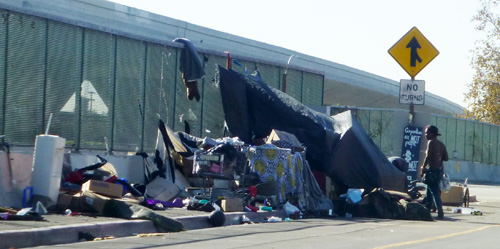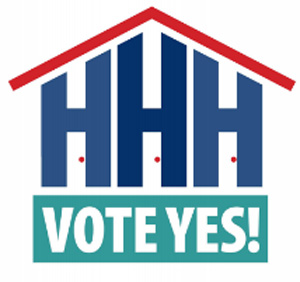To End Homelessness in LA: Vote Yes on Prop HHH November 8

Leslie Evans
Homelessness has been increasing in our city and county year by year. It has spread outward from its confines in Downtown’s Skid Row throughout the county. There are now 28,000 homeless people in the city and 46,000 in the county as a whole. Tent camps are springing up in alleys, under freeway bridges, in empty lots, and on street corners everywhere. This is a human misery crisis for those living this life, a public health and livability crisis for everyone else. Only a major redirection of resources can stop this unacceptable situation from growing worse.
Short-term shelters, though they are of great value in providing beds and often meals, have little or no effect in reducing the numbers on the street. The one proven method, in many cities, is permanent supportive housing. This means some kind of small housing units, backed up with on-site professional case management. Some 90% of homeless who have received such housing in other cities remain off the streets two years later.
This requires big time money. But it has been proven to be much cheaper than leaving the homeless on the streets. In 2015, the city of Los Angeles spent $100 million on police, jails, Sanitation, and emergency health services directed toward the homeless, with no effect in reducing their numbers.
Our November ballot, among the 24 other measures, includes Proposition HHH, which would issue bonds in the amount of $1.2 billion for the construction or purchase of units that can house 10,000 of the homeless. The construction and acquisition would take place over 10 years and be paid for with a modest increase in property taxes – averaging $9.64 per $100,000 of home value. This is based on assessed value, which is usually much lower than actual market rate.
The ballot is unusually long, and many voters may not be prepared to vote on a lot of the measures. It is important that they do find Prop HHH.

Proposition HHH appears on the last page of the ballot, the first of 4 measures under the heading CITY.
Funding measures require a two-thirds majority to pass (67%). Ppoll are giving HHH a comfortable margin, but that depends on people actually filling in their mail ballots or going to the polls on election day. If Prop HHH fails, things will actually get worse. This year the city committed an extra $100 million to combat homelessness. This was a one-time allocation. Once gone, if HHH fails, things will be worse than they are now.
The game plan to end homelessness
Proposition HHH is restricted to investment in physical properties. The 10,000 units it will construct or remodel are aimed mainly at the chronically homeless (80% of the new units must include on-site case management). These homeless are the most visible: the occupants of street camps. Most are mentally ill, substance addicted, or disabled. Permanent supportive housing requires on-site case management to stabilize this difficult population. Those costs must be in addition to the buildings. They are to be covered by Los Angeles County.
In the big picture, about 156,000 people are homeless in LA County for part of each year. Most are rehoused in about 3 to 4 months. The hardcore remain.
About 25,000 units of permanent supportive house are needed for the currnetly chronic homeless; 9,000 already exist. The city’s part of the need is a little under 10,000 units, the point of Proposition HHH.
The county shoulders the rest. Its job is to provide mental and physical health services for the long-term homeless, but also rapid rehousing for the larger number of temporarily homeless, who are capable of functioning on their own once they get past this tough spot in their lives. In total, the county has to come up with about $1.4 billion for its part of the job. It has some of these funds. The remainder are expected to be raised by a quarter-cent increase in the sales tax, to appear on the March 2017 ballot.
On the Prop HHH housing, costs are running around $420,000 per individual unit, with a three-to-five-year lead time from initiation to completion. Much of this delay is tied up in approvals. Developers are private companies, both profit and nonprofit. They must acquire the land and plan approvals before they are eligible for any Los Angeles subsidies or tax credits. Most projects limit themselves to 49 units or less, as anything larger triggers an environmental impact review, which can add two years to completion time. This means there will be upwards of 200 projects, most of which will likely encounter local homeowner opposition. Everyone wants the homeless off the streets, but for most, not too near to where they live.
The city will fund each project roughly in the amount of $150,000 per unit. Another 65% of funding comes in the form of federal tax credits. The city has identified about 24 properties it owns that can be used for homeless housing.
Because of the vast number who are homeless part of the year, and the lag time for even rapid rehousing of the able majority, these investments are expected, at the end of the ten-year building program, to still leave about 14,000 people homeless in Los Angeles County at any one time. While the money looks large, $1.2 billion over ten years comes to $120 million on average in any one year. The city’s 2016-2017 budget is $8.75 billion. The $120 million amounts to 1.4% of that amount.
New Regional Homelessness Advisory Council (RHAC) to Coordinate Countywide Homeless Policy
Los Angeles has a joint county-city agency to oversee the battle to end homelessness: the Los Angeles Homeless Services Authority (LAHSA). The intractability of the problem led city and county authorities at the beginning of 2016 to look for a format that would expand LAHSA’s connections to the many players in the city and county whose resources or expertise can contribute to solving the homeless crisis. These include mental health services, hospitals and clinics, the police, churches, businesses, schools, and the many public nonprofit and charitable groups that provide services of many kinds.
Both the city and county late last year developed detailed plans for combatting homelessness. Seeing the need for input from the myriad organizations outside of LAHSA, it was decided to create a 52-member Regional Homelessness Advisory Council, to be convened by LAHSA in collaboration with Home for Good, a multi-agency program run by the United Way.
The RHAC is to meet quarterly, and in turn select a smaller subcommittee, the Los Angeles Continuum of Care Board, to directly advise LAHSA on a more regular basis. The Los Angeles Continuum of Care is the whole of Los Angeles County except for Glendale, Pasadena, and Long Beach, which make their own arrangements on urban policy.
RHAC membership is to be very broad. It will have one representative each from major city departments such as Housing, Economic Development, the city Administrative Officer, and LAPD. The county will be heavily represented, with reps from the departments of Mental Health, Health Services, and Public Health, Children and Family Services, Public Social Services, as well as the Probation and Sheriff’s departments.
Three seats will go to business organizations, two to faith-based groups, and two to philanthropic funders. Education will have representatives from LAUSD, UCLA, USC, and the LA Community College District. Two formerly homeless people will serve on RHAC.
Finally, each of the County’s 8 Service Planning Areas (SPAs) will have one representative, except for SPA4, which includes Skid Row, which will have 2.
Selections of representatives are going on now. The 8 SPAs mostly have coalitions of service providers and concerned people. They will elect their representatives in November. The RHAC is supposed to have its first meeting in February 2017. It will choose the smaller LA Continuum of Care Board in April and May, and the LA CoC Board will begin to work with LAHSA in June.
Comments
Leave a Reply
You must be logged in to post a comment.



